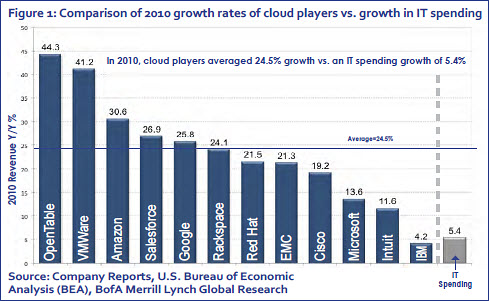CIO view: Consumerization and the impact on IT

Even the most casual observer of enterprise software can see the growth and importance of cloud computing. For example, SAP's purchase of SuccessFactors for $3.4 billion and Oracle's acquisition of Taleo for $1.9 billion make clear that cloud is now part of mainstream enterprise software.
While the growth of cloud is obvious, the impact on IT is less clear. Consider the following chart from a report by the SandHill Group (and sponsored by SAP):

The chart shows the growth of IT spending compared to growth rates of a variety of cloud-focused technology companies. This chart demonstrates a cloud growth dynamism that is impossible to ignore, especially in light of the comparatively small IT growth rate. Although OpenTable, the growth leader shown above, is a consumer company, the chart represents a substantial enterprise component.
Next, look at this graph, showing that Facebook has 901 active million users every month:
With so many users, Facebook itself has become a cultural force in society, helping drive profound shifts in consumers' expectations of technology. When these expectation shifts meet the enterprise, we call it the "consumerization of IT." I've recently spent time with folks from salesforce.com, which uses the term "Social Enterprise" to describe the impact of cloud, social, and mobile on the enterprise.
Now, consider the following statistics, from Gartner (registration required) and PriceWaterhouseCoopers (reported by ComputerWorld):
The conclusion is inescapable: Cultural shifts, combined with cloud as an enabler, have given end-users and lines of business greater control over technology in the enterprise.
Some IT folks, however, may find this inevitable trend disruptive and challenging. Although it is true that some IT roles will evolve as the transition to end-user computing in the enterprise takes hold, successful cloud transformation requires partnership between lines of business and a robust IT organization.
TEN POINTS OF BUSINESS ADVICE FOR IT IN A CLOUDY WORLD
The transition to cloud and consumer-centric technology creates opportunity for wise CIOs who embrace, rather than fear, this natural evolution of computing. To help lead cloud transformation in your company, consider following these points:
- Share your expertise on moving to the cloud with line of business folks in your company
- Provide the facts about opportunities and risk when moving to the cloud
- Serve as the cloud-provider clearing house for your organization
- Help the business select the right system integrator
- Take the lead on developing your company's a cloud strategy and transformation roadmap
- Help your business counterparts adapt to the new technology
- Assess on-premise systems to determine the best cloud migration path
- Create a long-term cloud delivery model and strategy
- Lead the effort to standardize security, backup, and other centralized policies as they relate to cloud computing
- Engage senior management to ensure that cloud computing initiatives support your company's core strategies
As part of a research project into use of cloud, mobile, social, and advanced network infrastructure, professor Lydia Segal and I have recently interviewed numerous innovative CIOs at institutions of higher education. [Disclosure: sponsored by Enterasys with support from salesforce.com.]
Among our findings:
The most successful and innovative CIOs lead the cloud transition in ways that directly support their organization's key mission; these top performers also engage other senior leaders in meaningful and ongoing dialog. The combination of sound strategy and active engagement is powerful and does work!
Bottom line: The consumerization of IT offers tremendous opportunity to CIOs possessing the leadership skills and vision to engage substantively with line of business counterparts.
====================
On May 13, 2012 colleagues and I will deliver a workshop addressing business transformation in the cloud as part of the pre-conference activities at SAP's upcoming SapphireNow conference. For more information, click this link.